< Back
to Documents
< Previous
Next >
Collectible Haggadahs of Pesach - Antique Passover Haggadot
Rare and Antique Jewish Passover Haggadot - Printed and Published in European Capital Cities where Jews used to live
Hagada shel Pesach - Warszawa 1928, Seder Marbe Le-saper ve-hu Hagadah shel Pesah - Prague 1849
The Haggadah of Pesach (in Hebrew Hagada shel Pesach - also spelled Haggada or Aggada) is a Jewish religious text which sets out the ritual for Passover Seder AKA Passover Eve. Reading the text of the Hagada and managing the Seder ritual is considered to be part of the Jews obligation to expand on the stories of the liberation of the Hebrews from slavery in ancient Egypt as said in the book of Exodus xiii. 8 "And thou shalt tell thy son in that day, saying, It is because of that which the Lord did for me, when I came forth out of Egypt."
Probably, the first mention of any such ritual is found in the Mishnah where it is reported that Rabban Gamaliel the second who said, "One who has not said these three words on Passover has not done his duty: Pesach, Mazzah and Maror" and expressed the idea that the eating in Passover Eve does not fulfill the law in Ex. xiii. 8 if the spiritual meaning of the act is not recognized. It is now quite agreed among scholars that Gamaliel arranged the Passover ritual, just as he arranged the Jewish rituals for the daily service and for the grace after meals, because the destruction of the Temple had made it necessary to find new methods of public worship.
Existing manuscripts of the Hagada shel Pesach do not go back beyond the thirteenth century, the time, probably, when the service for Passover Eve was first written separately and although the Jewish printing community was quick to adopt the printing press as a means of producing scripture texts, the general adoption rate of printed Haggadot (the plural form of Hagada in Hebrew) was relatively slow. It is not until the nineteenth century, when more than 1,000 separate printed editions were published, that a significant shift is seen toward printed Haggadot as opposed to handwritten editions. In the following we present several rare and antique Haggadot which were printed and published in Europe in the 19th and 20th century - I invite you to have a look.
***
Hagada shel Pesach - Warszawa 1928 - Zaklad Graficzny "Stereotyp" - Tow. Wyd. "Central"
הגדה של פסח מצוירת עם באורים - הוצאת בית הדפוס "סטראוטיפ"
ע"י חברת "צנטרל" - ורשה תרפ"ח - 1928
This beautiful Hagada was published in Warsaw, Poland in 1928 by the renowned Jewish publishing house "Central" who was involved with many Hebrew and Yiddish publications at the 20s and 30s of the 20th century. The printing house of this publication was "Stereotyp" which resided in Nowolipki 7 street at the same building as the "Central" publishing house and several other Jewish printing and publishing businesses.
Warsaw which was at that period populated with 400,000 Jews, was the center of Hebrew publishing in Poland and many famous Jewish writers either lived or worked in the city, including: Isaac Bashevis Singer, Shalom Asch, I.L. Peretz, David Frischman and Nachum Sokolow. By the start of World War II, more than 1,000 Jewish workers were involved in Hebrew printing works in Warsaw.
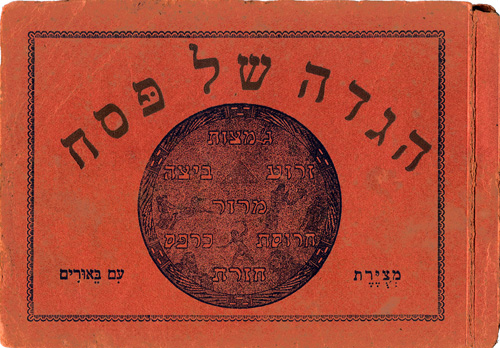
עמוד הכריכה - הגדה של פסח מצוירת עם באורים - ורשה תרפ"ח 1928
בוורשה של שנות העשרים התגוררו כ-400,000 יהודים שהיוו בשלב מסוים כ-40 אחוזים מתושבי העיר. פולין כולה, היתה, בתקופה שלפני מלחמת העולם השניה, מרכז יהודי שוקק ורב תרבותי כאשר הזרמים הארגוניים והציבוריים מרובים ומתפצלים בין דתיים אותודוקסים וחרדים לבין ציונים וסוציאליסטים, והשפות אידיש, פולנית ועברית משמשות בערבוביה. לכאן או לכאן, הקהל היהודי אהב את האות העברית הכתובה והיה צמא לדברי דפוס בשפה העברית המתחדשת, ומה יכול היה לשמש כמכנה משותף מירבי, ולקסום ללקוחות רבים ללא תלות בזרם ובמפלגה, יותר מההגדה של פסח בעברית ?
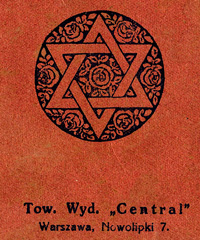
הגדה של פסח מצוירת עם באורים - הוצאת בית הדפוס "סטראוטיפ" ע"י חברת "צנטרל" מרחוב נובוליפקי 7 בוורשה
ההגדה היפיפיה שלפנינו שיצאה בהוצאת צנטרל מרחוב נובוליפקי 7 בוורשה, היא דוגמא ליזמות היהודית בדורותיה - הוצאת צנטרל, שהתמחתה בהפקת ספרים באידיש ובעברית (בין היתר הוציאה לאור את כל כתבי מנדלי מוכר ספרים) הפיקה רב-מכר: הגדה קלילה, בפורמט שולחני נוח, מעוטרת בחינניות ובעיקר מבוארת בעברית צחה ומאירת עיניים ובמחיר שווה לכל נפש. וכך תיאר עורך המהדורה את המוצר: הגדה של פסח - עם באור עברי ועם דברי אגדה - מכיל מבחר האגדות על דבר יציאת מצרים - מצויר בציורים אמנותיים עתיקים. העמוד הראשון של ההגדה מנחה את בעל הבית כיצד בודקים ומבערים את החמץ לפני החג:
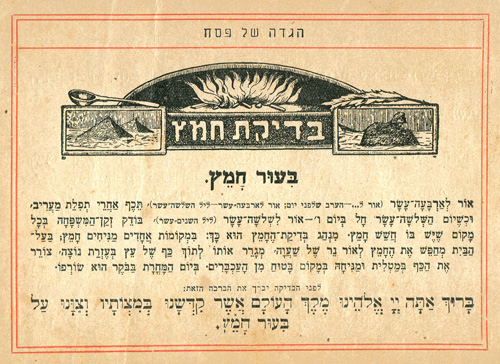
הגדה של פסח מצוירת עם באורים - ביעור חמץ - ורשה תרפ"ח
ביעור חמץ - אור לארבעה עשר, תכף אחרי תפילת מעריב, ...בודק זקן-המשפחה בכל מקום שיש בו חשש חמץ. מנהג בדיקת החמץ הוא כך: במקומות אחדים מניחים חמץ; בעל הבית מחפש את החמץ לאור נר של שעווה, מגרד אותו לתוך כף של עץ בעזרת נוצה, צורר את הכף במטלית ומניחה במקום בטוח מן העכברים. ביום המחרת בבוקר הוא שורפו. ואכן הבאורים וההסברים מוגשים בשפה קלה תוך הדגש על ההיבט הפרקטי של ההנחיות. גם דברי האגדה שבסוף החוברת מרנינים - סיפורים מרתקים שהעצימו את תחושת החג והרחיבו את נפלאות הסיפור התנכי המקורי. בהחלט מן הראוי היה להציג כאן מדגם כלשהו מהם ואולי נעשה זאת ביום מן הימים.
בנוסף, כפי שמבטיח המו"ל, מופיעים בהגדה מספר ציורים אמנותיים עתיקים, חלקם מיניאטורות הלקוחות מהדפסים שרווחו בהגדות המאה ה-19, ויש אפילו שתי רפרודוקציות המתבססות על ציוריו הקלאסיים של גוסטב דורה: משה ואהרון לפני פרעה ו-ותרד בת פרעה לרחוץ על היאור ותרא את התיבה בתוך הסוף. אך בעיקר מצא חן בעיני הציור שלפניכם - לא הצלחתי לזהות את האמן שציירו - תחריט המתאר משפחה יהודית המסיבה לליל הסדר. משפחה יהודית מן המעמד הבינוני בזמן ובמקום שהגדה זו הודפסה - תא משפחתי קטן, שילוב דורות, מאור פנים, גברים, נשים וילדים, נינוחות של אילו שלא תיארו לעצמם את העתיד לבוא בזמן קצר.
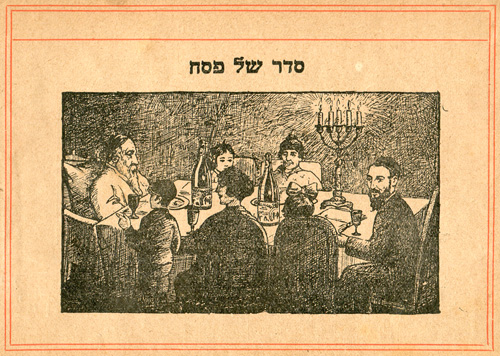
Hagada shel Pesach - Poland, Warsaw 1928 - Published by "Central" - The scene of a Jewish family celebrating the Seder
If you have something particular in mind that you wish to ask, you are invited to write to me and I will send you additional information regarding this unique Hagada shel Pesach.
Softcover: 86 pages with several engravings and reproductions in black and white
Publisher: Central publishing house, Warszawa, Poland; First Edition 1928
Language: Hebrew.
Price: Call
***
Seder Marbeh le-saper ve-hu Hagadah shel Pesah - Prag 1849 - Druck und Verlag des M.I. Landau
סדר מרבה לספר והוא הגדה של פסח - מתרגם, מוציא לאור ומדפיס:
משה ישראל לנדאו - פראג 1849
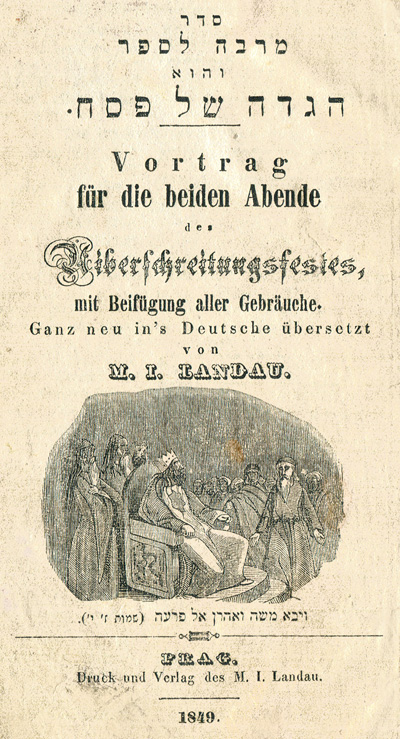
סדר מרבה לספר והוא הגדה של פסח - עמוד השער - מתרגם, מוציא לאור ומדפיס: משה ישראל לנדאו - פראג 1849
This important copy of Hagadah for Pesach, was published in Prague in 1849 for the German speaking Jewish population which resided in the Austrian Empire and in the German Confederation. The Jewish culture of this era was greatly influenced by the ideas of the German Jewish philosopher Moses Mendelssohn (1729-1786) which redefined the position of Judaism in the Gentile world. Mendelssohn wrote:
Brothers, if you care for true piety, let us not feign agreement, where diversity is evidently the plan and purpose of Providence. None of us thinks and feels exactly like his fellow man: why do we wish to deceive each other with delusive words?
Mendelson also translated the Torah into German and encouraged the Jews to write and speak the German language and to participate in the German culture and secular science. His works and writings inspired the Jewish Enlightenment movement AKA the Haskalah that flooded the Jews in Central Europe. Prague became one centre of this movement, together with Berlin and Vienna. The Seder Marbeh le-saper ve-hu Hagadah shel Pesah or in its German title:
Vortrag
fur die beiden Abende
des
Uiberschreitungsfestes,
mit Beifugung aller Gebrauche.
Ganz neu in's Deutsche ubersetzt
von
M. I. Landau
is an excellent example of the contribution of Prague to the trend of the Jews in Central Europe to culturally integrate with their neighborhood. Moshe Israel Landau (1788 - 1852), a printer and publisher, one of Prague's leading Jewish figures and a moderate enlightener, translated the Hagada text from Hebrew to German and produced a beautifully illustrated German-Hebrew bilingual edition which made the liturgical text of the Hagada accessible to both Hebrew and German speakers.
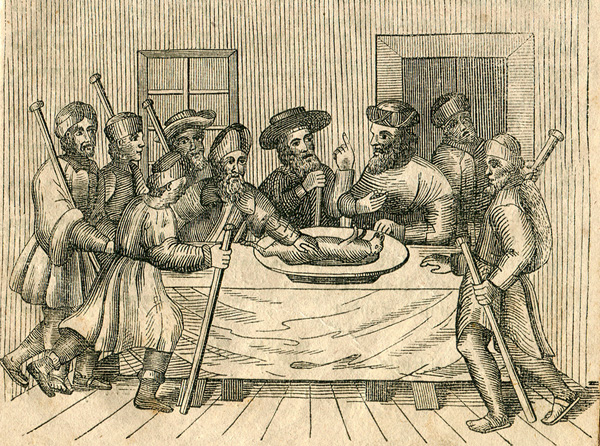
Seder Marbeh le-saper - M.I. Landau, Prague 1849
![]()
Pesach Offering - Hagada shel Pesach Prague 1849 Published by M.I.Landau
הגדה של פסח - משה ישראל לנדאו פראג 1849 - ואת המטה הזה, תיקח בידך, אשר תעשה בו, את האותות
תנועת ההשכלה היהודית שסחפה את יהודי מרכז אירופה בהשראת רעיונותיו וכתביו של משה מנדלסון, הגיעה בתחילת המאה ה-19 גם אל יהודי מזרח אירופה, שם קיבלה אופי שונה במקצת. לקראת המחצית השנייה של המאה ניתן היה להבחין בשני זרמים עיקריים: זרם אחד, שבלט במיוחד בגרמניה ובמערב אירופה, שאף לשלב את היהודים בחברה הכלכלית, הנוצרית, ולהכניס שינויים ותיקונים בדת היהודית בהתאם. הזרם השני, שבלט במיוחד במזרח אירופה, ביקש להדגיש את ייחודו של העם היהודי תוך הרחבת אופקיו של היחיד אל התרבות שמסביב.
היחס לשפה הוא אחת הדוגמאות להבדלים אלה: המשכילים היהודים במערב אירופה העדיפו את הלימוד והשימוש בשפת המדינה (גרמנית, צרפתית או אנגלית), ואילו המשכילים היהודים במזרח אירופה, עודדו את לימוד השפה העברית ואת השימוש בה - לצד הלימוד של שפת המדינה.
ההגדה החשובה והמיוחדת שלפניכם נערכה והודפסה בפראג 1849 על ידי משה ישראל לנדאו (1788 - 1852) מראשי הקהילה היהודית בעיר ובעל הוצאה לאור שהתמחתה בהפקת ספרי קודש וספרים ברוח תנועת ההשכלה. לנדאו, שהיה שייך לזרם המשכילים היהודים המתונים, תרגם את ההגדה לגרמנית והציג את הטקסט העברי המוקפד לצד הטקסט הגרמני המתורגם - עמודה מול עמודה, שורה מול שורה.
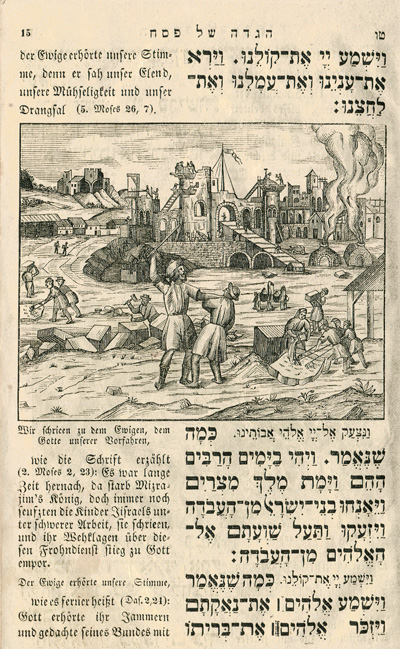
סדר מרבה לספר והוא הגדה של פסח - עברית וגרמנית - מתרגם, מוציא לאור ומדפיס: משה ישראל לנדאו - פראג 1849
לנדאו שילב בהגדה הדפסים משובחים ואיכותיים המציגים סצנות מסיפור ההגדה על רקע הנוף ואורחות החיים של תקופת הרנסאנס האירופאי שנחשבו על ידי האמנים המאיירים כמייצגים נאותים של התקופה העתיקה שבה התרחשו עלילות ההגדה. בתמונה שמעל מכה המשגיח "המצרי" את העובד "העברי" באתר בנייה אופייני למרכז אירופה של המאה ה-16. בתחריט שלמטה אנו רואים את שולחן הסדר כפי שדמיין אותו האמן: ארמון. חדר מפואר. הוד והדר. הגברים, לבושים מחלצות כאצילים, בקדמת השולחן, מספרים את סיפורי יציאת מצריים, הנשים, במרומז בצד הימני הרחוק, המשרתים, מגישים התקרובת ומוזגים יין וכולם מוארים באור נגוהות הבוקע ממנורת קנים שבה מגן דוד קטן. חג שמח.

Antique Hagada shel Pesach - Czech, Prague 1849
![]()
Antique Hagada shel Pesach - Czech, Prague 1849 - Published by M.I.Landau - The scene of a Jewish family celebrating the Seder.
The Haggadah shel Pesach, being the chief Jewish ritual work for home use in which none of the questions in regard to using human figures for decorative purposes could arise, afforded manifold opportunities for illustration. Generally speaking, the topics illustrated were either (a) historic, centering upon the Exodus; (b) Biblical, reproducing Biblical scenes without definite reference to the Exodus; or (c) domestic, relating to the actual scenes of the Seder service like the one in the upper engraving which presents the gathering Jews as European knights celebrating in a princedom palace - wishful thinking?
Hardcover: 63 pages with several black
and white woodcuts illustrations
Publisher: Druck und Verlag des M.I. Landau, Prag, 1849
Language: Hebrew & German.
Price: Call
References:
Ozar haHagadoth by Isaac Yudlow - 932
Bibliography of the Passover Haggadah by Avraham Yaari - 685
if you wish to have more details about these lots of collectible Haggadot, contact me and I will send you further information including full description of the book's condition as well as a photograph of the cover, price and shipping cost. These rare books were kept in our family with great care.
Item: D1015 - Collectible Haggadot shel Pesach
© Dan Levy - Art Pane Home of Collectible Judaica